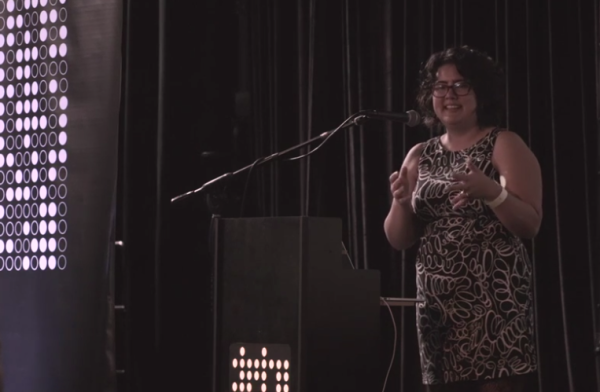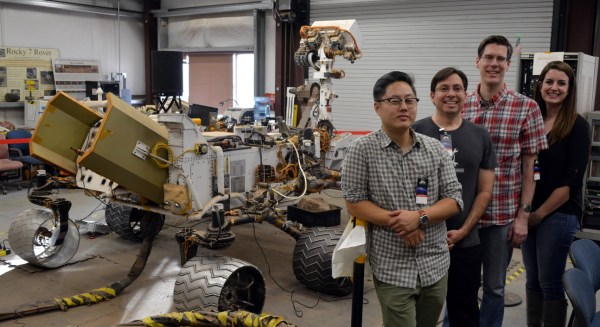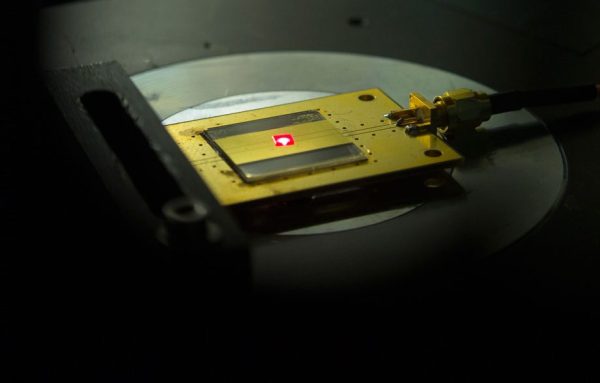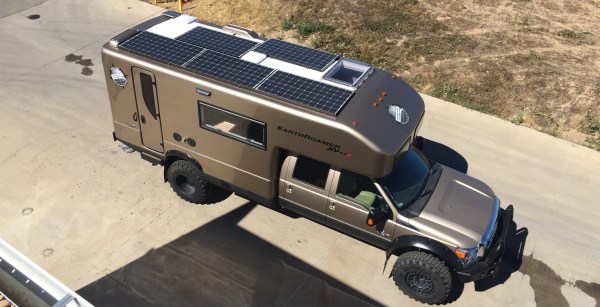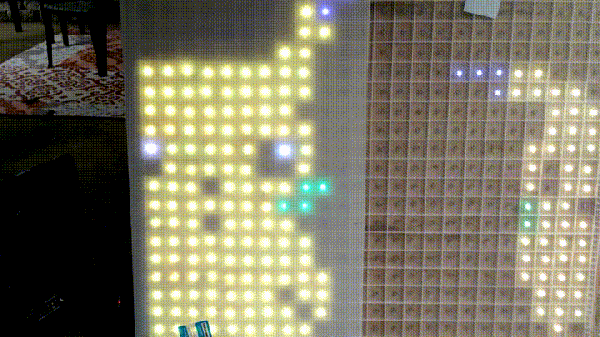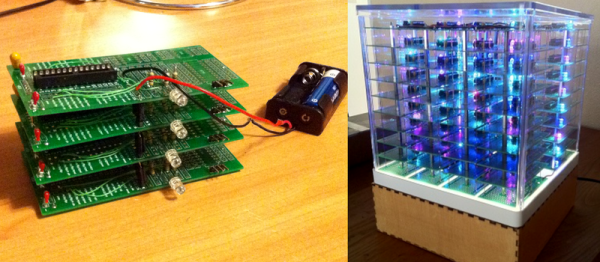What will next generation space suits look like? Kari Love is making the case that new space suits will exhibit the best in soft robot technology. The problem is that most people don’t really understand much about soft robots, or about space for that matter. Her talk at the Hackaday SuperConference explores the research she has been doing into future generations of space suits. Check out the video below and then join us after the break for more on this topic.
Month: December 2016
Extra Curricular Tour Of NASA’s Jet Propulsion Laboratory
Last week, Hackaday had the chance to tour NASA’s Jet Propulsion Laboratory (JPL) in Pasadena, California. Tours are given all the time at JPL, but ours was special. Steve Collins invited us, and acted as our tour guide, and a new friendship with Michelle Easter got us a look inside the labs where equipment for the 2020 Mars mission is being built.
Continue reading “Extra Curricular Tour Of NASA’s Jet Propulsion Laboratory”
Hacked Diamond Makes Two-Atom Radio
It used to be pretty keen to stuff a radio receiver into an Altoid’s tin, or to whip up a tiny crystal receiver from a razor blade and a pencil stub. But Harvard researchers have far surpassed those achievements in miniaturization with a nano-scale FM receiver built from a hacked diamond.
As with all such research, the experiments in [Marko Lončar]’s lab are nowhere near as simple as the press release makes things sound. While it’s true that a two-atom cell is the minimal BOM for a detector, the device heard belting out a seasonal favorite from [Andy Williams] in the video below uses billions of nitrogen-vacancy (N-V) centers. N-V centers replace carbon atoms in the diamond crystal with nitrogen atoms; this causes a “vacancy” in the crystal lattice and lends photoluminescent properties to the diamond that are sensitive to microwaves. When pumped by a green laser, incident FM radio waves in the 2.8 GHz range are transduced into AM fluorescent signals that can be detected with a photodiode and amplifier.
The full paper has all the details, shows that the radio can survive extreme pressure and temperature regimes, and describes potential applications for the system. It’s far from a home-gamer’s hack at this point, but it’s a neat trick and one to watch for future exploitation. In the meantime, here’s an accidental FM radio with a pretty small footprint.
Off-Grid Travel — Setting Up A Solar System
When you’re living out of a vehicle, or even just traveling out of one, power quickly becomes a big concern. You need it for lights, to charge your various devices, to run your coffee maker and other appliances, and possibly even to store your food if you’ve got an electric refrigerator. You could do what many RV owners do: rely on campgrounds with electrical hookups plus a couple of car batteries to get you from one campground to the next. But, those campgrounds are pricey and often amount to glorified parking lots. Wouldn’t it be better if you had the freedom to camp anywhere, without having to worry about finding somewhere to plug in?
That’s exactly what we’re going to be covering in this article: off-grid power on the road. There are two major methods for doing this: with a portable gas generator, or with solar. Gas generators have long been the preferred method, as they provide a large amount of power reliably. However, they’re also fairly expensive, cumbersome, noisy, and obviously require that you bring along fuel. Luckily, major advances in solar technology over the past decade have made it very practical to use solar energy as your sole source of electricity on the road.
Continue reading “Off-Grid Travel — Setting Up A Solar System”
Hacking Google Daydream To Work With IOS
The Google Daydream is a VR headset with a controller, and according to the folks at Google, “It’s not currently compatible with iOS and won’t be for several years probably.” OK.
This inspired [Matteo Pisani] to get to work on the protocol that it uses to speak with Android phones. Cutting to the chase, he got it working in several days.
There really wasn’t all that much to it. The controller sends data over Bluetooth, and [Matteo] noticed an “unknown” device on the network. Looking inside the data that it sent, it changed when he moved the controller. Not so unknown now! The rest of the work consisted of writing applications to test hypotheses, waving the controller around, and finding out if he was right. Read up if you’re interested in implementing this yourself.
We love protocol hacks here. From running quadcopters on your own remotes, to simply trying to turn on a lightbulb, it’s getting more and more important that we understand the various languages that our devices speak.
Massive Pixel Display Holiday Decoration
Decorating for the holidays is serious business! Finding themselves surrounded by neighbours who go big, redditor [wolfdoom] decided that this was the year to make a strong showing, and decided to build an oversized pixel LED display.
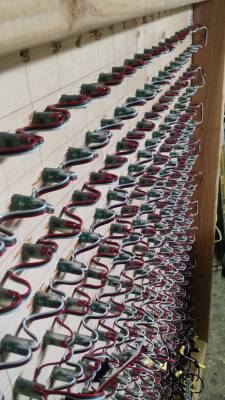 Demonstrating resourcefulness in their craft, [wolfdoom] found an old fluorescent light grid pattern to prevent bleed from one pixel to the next. Reusing this grid saves many hours of precision-cutting MDF — to be substituted with many hours of cutting the plastic with decidedly more room for error. Attaching the resulting grid to a sheet of plywood, and 576(!) drilled holes later, the LEDs were installed and laboriously wired together.
Demonstrating resourcefulness in their craft, [wolfdoom] found an old fluorescent light grid pattern to prevent bleed from one pixel to the next. Reusing this grid saves many hours of precision-cutting MDF — to be substituted with many hours of cutting the plastic with decidedly more room for error. Attaching the resulting grid to a sheet of plywood, and 576(!) drilled holes later, the LEDs were installed and laboriously wired together.
A Plastic light diffusing sheet to sell the pizel effect and a little help from their local maker space with the power circuit was enough to keep this project scrolling to completion — after the requisite period of basement-dwelling fabrication.
Despite some minor demotion attributed to a clumsy daughter, the massive 4×4 display remained a suitably festive decoration. For now the control system remains in [wolfdoom]’s basement, but with plans to incorporate it into the display’s frame down the road.
One of the more interesting LED matrix builds we saw this year is the one that uses 1575 beer bottles. For a more interactive holiday decorations, Halloween usually takes the cake — like this animated door knocker.
[via /r/DIY]
80-PIC32 Cluster Does Fractals
One way to get around limitations in computing resources is to throw more computers at the problem. That’s why even cheap consumer-grade computers and phones have multiple cores in them. In supercomputing, it is common to have lots of processors with sophisticated sharing mechanisms.
[Henk Verbeek] decided to take 80 inexpensive PIC32 chips and build his own cluster programmed in — of all things — BASIC. The devices talk to each other via I2C. His example application plots fractals on another PIC32-based computer that has a VGA output. You can see a video of the device in action, below.

